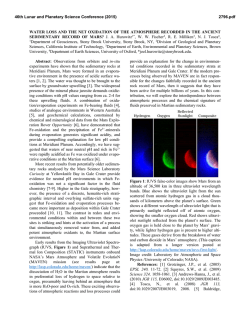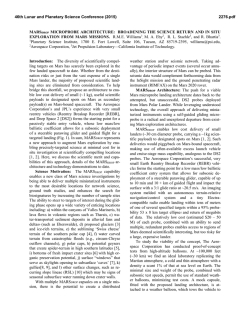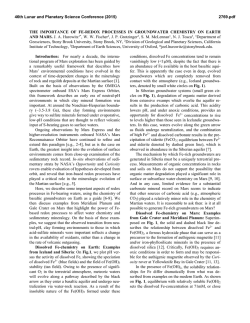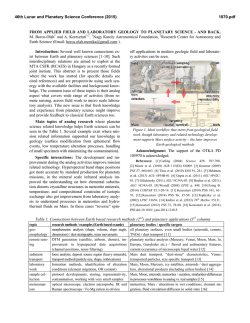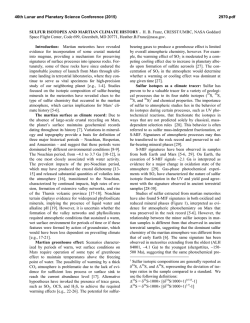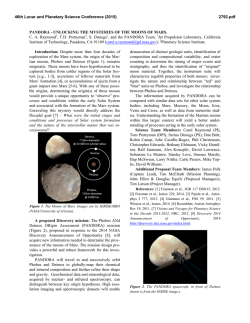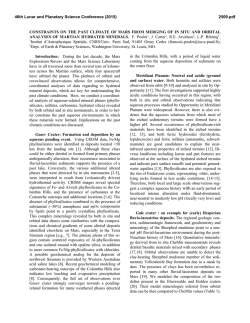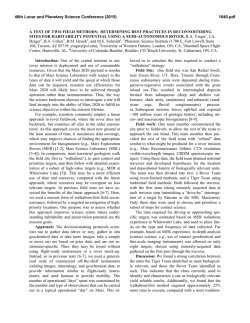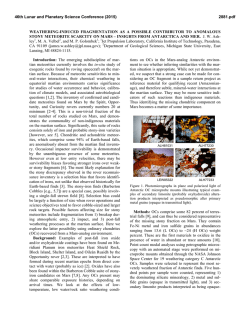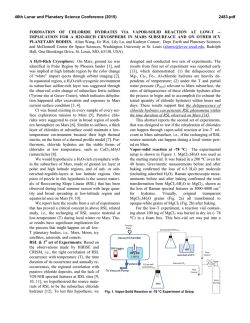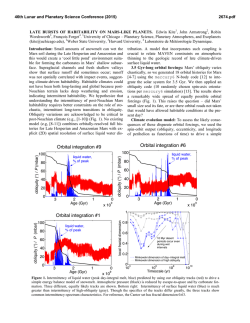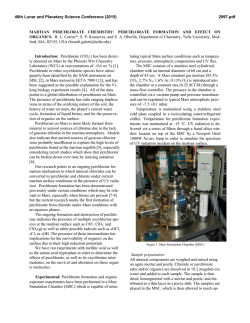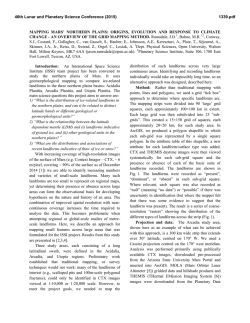
Potential Mineral Resources On Mars: Ore Processes And
46th Lunar and Planetary Science Conference (2015) 1491.pdf Potential Mineral Resources On Mars: Ore Processes And Mechanisms. J. R. Crandall1 and J. Filiberto1, 1 Department of Geology, Southern Illinois University Carbondale, 1259 Lincoln Road, Mailcode 4324, Carbondale, Illinois, 62901, USA ([email protected]). Introduction: Ore-forming processes are relatively well understood on Earth, but little is known about mineralization processes on Mars. By applying terrestrial analogs, using data collected from orbital and rover missions and evidence for hydrothermal activity from alteration assemblages, the types and locations of different ore-forming processes will be investigated with the aim of discovering concentrations of mineral resources on Mars. These resources are likely to be of critical importance for future manned missions to Mars, and insight gained towards mineralization on Mars may also advance our understanding of terrestrial deposits. Background: As of now, only two papers have addressed potential Martian mineral resources. West and Clarke [1] provided an overview of potential ore forming processes on Mars, but the amount of available data on the subject has increased dramatically since 2010. Baumgartner et al. [2] investigated the possibility that igneous activity may have led to the formation of sulphide mineral assemblages, though this mode of concentration would require a yet unidentified process to reach sufficient sulphur saturation. This project expands on the processes outlined by West and Clarke [1] with emphasis placed on impact related events, which may produce sufficient sulphide saturation as suggested by Baumgartner et al. [2]. Methods: To further investigate the occurrence of potential Martian mineral resources, especially those associated with impacts, multiple datasets have be correlated. The topography of Mars along with global mineralogical and aqueous history has been derived from data collected by instrumentation including the Mars Express Observatoire pour la Mineralogie, l´Eau, les Glaces et l´Activité (OMEGA), Mars Reconnaissance Orbiter (MRO) Compact Reconnaissance Imaging Spectrometer (CRISM) and Mars Odyssey Gamma-Ray Spectrometer (GRS). These instruments have been used to characterize and map most of the Martian surface with respect to crustal composition and surficial mineralogy [3, 4, 5, 6]. Terrestrial analogs and the understanding of alteration mineralogy have been applied where appropriate to approximate potential processes and mechanisms of ore concentration on Mars [7, 8]. Impacts as Ore Forming Processes: Terrestrial impact structures have produced some of the richest mineral assemblages on the planet, and may have economic potential on Mars [9, 10]. The southern hemisphere of Mars represents one of the most heavily cra- tered areas in our solar system, highlighting the important role of meteorite and comet impacts in shaping the surface of the planet [11]. The craters on Mars roughly fit into two categories, those that are less than 5 km in diameter with radial ejecta blankets similar to those on the moon, and larger craters that have lobate ejecta blankets that suggest that the Martian surface was water saturated at the time of impact [8, 12, 13, 14]. The energy transferred by an impact into the Martian surface has the potential to melt large quantities of rock and can expose mineral deposits of unrelated origin [1, 14]. Analyses of available terrestrial analogs may yield insight into potential mineralization processes associated with impacts on Mars. Ore-bearing terrestrial impact structures are broken into three classifications: progenetic, syngenetic and epigenetic [9, 10]: this classification scheme may be useful for describing impactrelated structures on Mars. Progenetic deposits are those that are present before an impact, but are modified during or after the impact event [9]. Terrestrial examples include the Witwatersrand ores associated with the Vredfort multi-ring structure (Fig. 1), the Ternovka structure (Fig 2), and the Canadian Carswell structure (Fig. 3) [1, 10]. Deposits formed as a direct result of the impact are known as syngenetic deposits, which include the Sudbury Igneous Complex in Canada [10]. Epigenetic deposits are the final group in the impact structure classification and are the most likely deposit type to occur on Mars [1]. Epigenetic deposits form as hydrothermal circulation develops in response to a magmatic heat source and eventually cools, depositing any materials previously in solution [1]. The fracturing associated with impacts provides the ideal channel for hydrothermal fluids to flow, cool, react with the wall-rock, and finally deposit elements to form economic concentrations [8, 13, 15]. Impactinduced hydrothermal circulation can produce assemblages similar to those associated with magmatic hydrothermal activity [1]. Implications: Our investigation focuses on Gusev and Gale (Fig. 4) craters due to the high probability of hydrothermal activity and the amount of data available due to their selections as landing sites for Mars Exploration Rover Spirit and Mars Science Laboratory, respectively [16, 17, 18]. Good coverage from TES, CRISM and OMEGA at these sites allows for the identification of minerals that are potentially indicative of ore concentrations such as phyllosilicates, sulphates and sulfides [16, 19, 20]. The combination of miner- 46th Lunar and Planetary Science Conference (2015) alogical data from the craters provided by orbital analyses with information from terrestrial analogs will allow for the identification of sites where ore mineral concentrations are likely to occur. References: [1] West M.D. and Clarke J.D.A. (2010), Planetary and Space Science, 58, 574-582. [2] Baumgartner R.J. et al. (2015), Ore Geology Reviews, 65, 400-412. [3] Boynton W.V. et al. (2004) Space Science Reviews, 110, 37-83. [4] Bibring J.-P. et al. (2005) Science, 307, 1576-1581. [5] Bibring J.P. et al. (2006) Science, 312, 400-404. [6] Murchie S. et al. (2007) JGR, 112, E05S03. [7] Filiberto J. and Schwenzer S.P. (2013) Meteorics & Planet. Sci., 48, 19371957. [8] Schwenzer S.P. and Kring D.A. (2013) Icarus, 226, 487-496. [9] Grieve R.A.F. and Masaitis V.L. (1994) International Geology Review, 36, 105-151. [10] Grieve R.A.F. (2013) Impact Cratering: Processes and Products, 177-193. [11] Carr M.H. and Head J.W. (2010) Earth and Planetary Science Letters, 294, 185-203. [12] Melosh H.J. (1989) Oxford Monographs on Geology and Geophysics, 11. [13] Abromov O. and Kring D.A. (2005) JGR, 110:E12S09. [14] Pirajno F. (2005) Australian Journal of Earth Sciences, 52, 587605. [15] Schwenzer S.P. and Kring D.A. (2009) Geology, 37, 1091-1094. [16] Schwenzer S.P. et al. (2012) Planetary and Space Science, 70, 84-95. [17] Squyres S.P. et al. (2004) Science, 306, 1709-1714. [18] Wray J.J. (2013) Int. J. Astrobiol., 12, 25-38. [19] Goudge T.A. et al. (2015) Icarus, 250, 165-187. [20] Thomson B.J. et al. (2011) Icarus, 214, 413-432. 1491.pdf Figure 2. Geology of the Ternovka impact structure, Krivoj Rog region, Ukraine [9]. Figure 3. Schematic geologic map of the Carswell impact structure, Saskatchewan, Canada [10]. Figure 1. Schematic geologic map of the Vredfort multi-ring structure, South Africa. Karoo cover rocks have been removed to display full extent of structure [10]. Figure 4. Mosaic THEMIS image of Gale crater. Credit: NASA/JPL-Caltech/Arizona State University/MSSS.
© Copyright 2025
